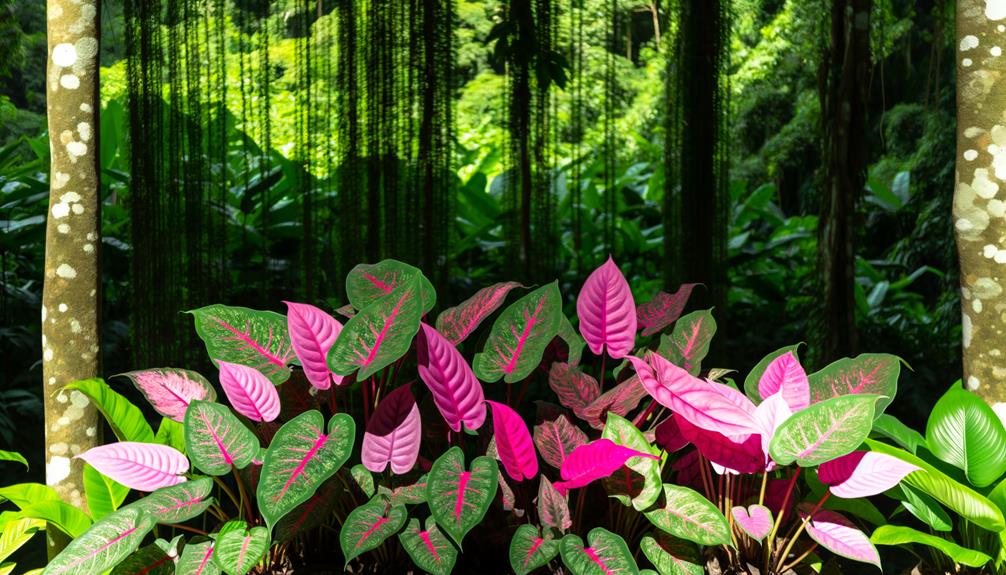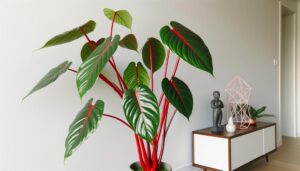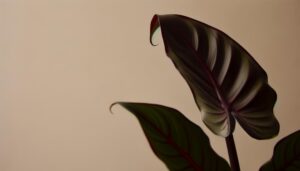What Are the Different Types of Pink Princess Philodendron?
The Pink Princess Philodendron (Philodendron erubescens) exhibits several variants. The Classic Pink Princess is distinguished by its striking variegation due to chlorophyll deficiency and heteroblastic growth.
The Pink Congo Variation is noted for its uniformly pink leaves, a result of chemical treatments, making it a unique study in ornamental horticulture. Hybrid Varieties offer diverse variegation patterns resulting from genetic variability, contributing to their unique aesthetic appeal and adaptability.
Variegation patterns in these plants, due to genetic mutations, present a spectrum from pink to green and white. For a thorough understanding of their morphology and care requirements, continue exploring the subject.

Key Takeaways
- Classic Pink Princess is renowned for its striking variegation due to chlorophyll deficiency.
- Pink Congo Variation features uniformly pink leaves achieved through chemical treatments.
- Hybrid Varieties captivate with diverse variegation patterns and enhanced adaptability.
- Variegation Patterns include pink, green, and white colors influenced by genetic mutations.
- Proper care involves bright, indirect light, high humidity, and well-draining soil.
Classic Pink Princess

The Classic Pink Princess Philodendron (Philodendron erubescens 'Pink Princess') is renowned for its striking variegation characterized by vibrant pink patches set against a backdrop of deep green foliage.
This variegated form belongs to the species Philodendron erubescens, native to South America, specifically Colombia. The variegation occurs due to a genetic mutation causing chlorophyll deficiency in certain leaf sectors, resulting in the characteristic pink coloration.
The 'Pink Princess' showcases heteroblastic growth, with juvenile leaves markedly differing from mature ones. Best growth conditions include bright, indirect light and well-draining soil, which are essential for maintaining its vivid variegation.
This cultivar is highly prized in horticulture, not only for its aesthetic appeal but also for its rarity and unique phenotypic expression.
Pink Congo Variation
Among the various philodendron cultivars, the Pink Congo Variation (Philodendron 'Pink Congo') is distinguished by its uniformly pink leaves, which differ markedly from the variegated patterns observed in the Classic Pink Princess. This cultivar belongs to the Araceae family, characterized by its striking, homogenous pink foliage resulting from chemical treatments rather than natural variegation.
The Pink Congo's leaves exhibit a consistent pink hue across their surface, making it visually unique among philodendrons. Unlike the Pink Princess, which displays a mix of pink and green, the Pink Congo's leaves retain their coloration for several months before gradually reverting to green. This phenotypic trait makes the Pink Congo a subject of interest in ornamental horticulture and plant physiology studies.
Hybrid Varieties

While the Pink Congo Variation captivates with its chemically-induced pink foliage, hybrid varieties of the Pink Princess Philodendron exhibit a diverse range of phenotypic expressions and variegation patterns resulting from crossbreeding efforts.
These hybrids belong to the Araceae family, under the genus Philodendron, and are cultivated for their unique aesthetic characteristics. Breeders have successfully combined the robust growth traits of Philodendron erubescens with the variegated allure of the Pink Princess.
Such hybrids are often characterized by a mix of pink, green, and white foliage, each plant displaying a unique variegation pattern due to genetic variability. The intentional hybridization enhances not only the ornamental value but also the adaptability and resilience of these philodendrons in various indoor environments.
Variegation Patterns
Variegation patterns in Pink Princess Philodendron manifest through intricate combinations of chlorophyll-deficient and chlorophyll-rich tissue, resulting in a striking display of pink, green, and occasionally white hues.
The variegation is due to genetic mutations within the plant's cells, classified under the species Philodendron erubescens. The pink variegation occurs when the cells lack chlorophyll, while green areas indicate chlorophyll presence, essential for photosynthesis. White variegation, rare yet possible, indicates complete chlorophyll absence.
The distribution of these colors may vary, ranging from speckles to sectoral or marbled patterns. These variegation patterns are not only visually enchanting but also influence the plant's overall health and growth, requiring careful cultivation for consistent aesthetic appeal.
Care Requirements

Proper care for Pink Princess Philodendron, a cultivar of Philodendron erubescens, is crucial to maintaining its distinctive variegation and promoting robust growth. This species thrives under specific conditions that replicate its native tropical environment. Key factors include ideal lighting, humidity, and soil composition.
- Light: Bright, indirect sunlight is essential to preserve variegation without scorching foliage.
- Watering: Maintain consistent moisture without waterlogging; allow the top inch of soil to dry between waterings.
- Humidity: Aim for humidity levels above 60% to mimic its natural habitat.
- Temperature: Preferential range between 65°F-80°F (18°C-27°C) should be maintained.
- Soil: Well-draining, aerated potting mix enriched with organic matter is ideal.
Adhering to these parameters ensures the Pink Princess Philodendron's best health and aesthetic appeal.
Growth Habits
When examining the growth habits of Pink Princess Philodendron (Philodendron erubescens 'Pink Princess'), it is important to distinguish between climbing and non-climbing varieties.
Additionally, variations in leaf size and morphology are influenced by genetic factors and environmental conditions.
Light requirements play an important role in determining the extent of variegation and overall plant vigor.
Climbing Vs. Non-Climbing
Distinguishing between climbing and non-climbing growth habits is essential for understanding the morphological diversity within the Pink Princess Philodendron (Philodendron erubescens). Climbing types exhibit a propensity for vertical growth, utilizing aerial roots and often requiring structural support.
Conversely, non-climbing variants manifest a more basal, self-supporting growth form. Recognizing these distinctions aids in appropriate cultivation practices and habitat replication.
- Climbing Habit: Utilizes aerial roots for attachment.
- Non-Climbing Habit: Generally more compact and self-supporting.
- Support Requirements: Climbers often need stakes or trellises.
- Growth Speed: Climbing types may exhibit more rapid vertical extension.
- Root Structure: Aerial vs. terrestrial root predominance.
This differentiation allows horticulturists to optimize care, ensuring robust growth and aesthetic appeal.
Leaf Size Variations
Leaf size variations in the Pink Princess Philodendron (Philodendron erubescens) exhibit significant morphological diversity, influenced by genetic factors and environmental conditions.
These variations manifest in the lamina dimensions, which can range from small, compact leaves measuring approximately 10 cm in length to larger, more expansive leaves exceeding 25 cm.
Genetic predispositions within different cultivars contribute to this heterogeneity, while environmental factors such as humidity, temperature, and nutrient availability further modulate leaf development.
Ideal growth conditions generally promote larger leaf sizes, enhancing the plant's photosynthetic efficiency and ornamental appeal.
Conversely, less than ideal conditions can stunt growth, resulting in reduced leaf dimensions.
Understanding these variables is essential for horticulturists aiming to cultivate specimens with desired morphological traits.
Light Requirements
Best light conditions for the Pink Princess Philodendron (Philodendron erubescens) are crucial for maintaining its variegated foliage and promoting vigorous growth. This species thrives under specific photic environments to support physiological and morphological development.
- Indirect sunlight: Maintains balanced chlorophyll production, preventing photodamage.
- Bright, filtered light: Encourages variegation without causing leaf scorch.
- Avoid direct sunlight: Guards against chlorosis and leaf burn.
- Consistent light exposure: Sustains steady photosynthetic activity and growth.
- Supplemental grow lights: Valuable in low-light conditions to sustain adequate illumination.
These light requirements are vital for preserving the aesthetic appeal and health of the Pink Princess Philodendron, thereby enhancing its ornamental value and promoting robust vegetative growth.
Choosing Your Plant

Choosing the suitable Philodendron erubescens 'Pink Princess' requires an understanding of its ideal growing conditions, including ideal light, humidity, and temperature requirements.
Additionally, obtaining your plant from reputable nurseries or botanical suppliers guarantees genetic integrity and plant health.
Ideal Growing Conditions
Best growth of the Pink Princess Philodendron (Philodendron erubescens) requires a controlled environment with specific light, temperature, and humidity levels. This species thrives under conditions that closely mimic its native tropical habitat.
Consider the following ideal parameters:
- Light: Indirect, bright light to prevent leaf burn and promote variegation.
- Temperature: Maintain between 18°C to 27°C (64°F to 80°F) for best growth.
- Humidity: High humidity levels, ideally between 60% and 80%.
- Soil: Well-draining, aerated substrate such as a mix of peat and perlite.
- Watering: Consistent moisture without waterlogging; allow the topsoil to dry slightly between waterings.
Adhering to these conditions will promote robust growth and vibrant pigmentation, characteristic of the Pink Princess Philodendron.
Sourcing Your Plant
When sourcing a Pink Princess Philodendron (Philodendron erubescens), it is crucial to obtain the specimen from a reputable nursery or specialist to guarantee genetic authenticity and best health.
Begin by verifying the supplier's credibility through reviews and references. Confirm the plant exhibits the characteristic variegation—distinct pink and dark green leaf patterns, a hallmark of genetic purity. Inspect the plant for signs of disease or pests, such as discolored leaves or webbing.
Consider sourcing from botanical gardens or horticultural societies known for maintaining high standards. Additionally, inquire about the plant's propagation method; specimens grown from cuttings often display more stable variegation.
Conclusion
To sum up, the Pink Princess Philodendron (Philodendron erubescens) showcases a captivating range of differences, such as the Classic Pink Princess, Pink Congo, and various hybrid types.
The patterns of variegation, care needs, and growth tendencies of these plants are crucial for prosperous cultivation.
Picking the right plant is akin to choosing a jewel from a treasure trove, as each presents distinct visual and botanical significance.
Adequate comprehension guarantees the flourishing and continuation of these plant wonders.






